 Deployment occurs in almost every branch of the military, and the experience differs for each family and each family member. To reflect the diversity of experiences, military professionals have proposed various models of the deployment cycle to assist families in the transition. There are at least five phases that are common across models: pre-deployment, deployment, sustainment, preparation (also known as redeployment), and reunification (or home-coming). Recognizing that each family is unique, this deployment cycle is intended not as a rule-book but as a helpful guide to families as they experience deployment of a parent. This 4-page fact sheet was written by Elizabeth Thomas and Larry F. Forthun, and published by the UF Department of Family Youth and Community Sciences, March 2013.
Deployment occurs in almost every branch of the military, and the experience differs for each family and each family member. To reflect the diversity of experiences, military professionals have proposed various models of the deployment cycle to assist families in the transition. There are at least five phases that are common across models: pre-deployment, deployment, sustainment, preparation (also known as redeployment), and reunification (or home-coming). Recognizing that each family is unique, this deployment cycle is intended not as a rule-book but as a helpful guide to families as they experience deployment of a parent. This 4-page fact sheet was written by Elizabeth Thomas and Larry F. Forthun, and published by the UF Department of Family Youth and Community Sciences, March 2013.
http://edis.ifas.ufl.edu/fy1368
Author: dihagan
Choose MyPlate: Reduce Your Sodium (FCS80027/FY1360)
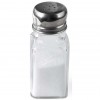 Reducing sodium intake is one of the MyPlate recommendations for healthy eating. Most Americans eat more sodium than they need, which can have negative health effects. This publication provides facts about sodium and why reducing sodium intake is important. It also provides easy tips to reduce your sodium intake. This 4-page fact sheet was written by Ashley Hamm, Karla P. Shelnutt, and Gail P. A. Kauwell, and published by the UF Department of Family Youth and Community Sciences, April 2013.
Reducing sodium intake is one of the MyPlate recommendations for healthy eating. Most Americans eat more sodium than they need, which can have negative health effects. This publication provides facts about sodium and why reducing sodium intake is important. It also provides easy tips to reduce your sodium intake. This 4-page fact sheet was written by Ashley Hamm, Karla P. Shelnutt, and Gail P. A. Kauwell, and published by the UF Department of Family Youth and Community Sciences, April 2013.
http://edis.ifas.ufl.edu/fy1360
Bottle-Feeding Your Baby (FCS80026/FY1359)
 Families choose to bottle-feed their babies for many reasons. While bottle-feeding is not difficult, you need to know several things to feed your baby safely and ensure that he or she receives the nutrition and bonding needed for proper growth and development. If you are considering bottle-feeding your baby or have decided that bottle-feeding is the best option for your situation, this publication will help you learn about bottle-feeding. This 5-page fact sheet was written by Sarah A. Schmidt, Karla P. Shelnutt, and Gail P. A. Kauwell, and published by the UF Department of Family Youth and Community Sciences, April 2013.
Families choose to bottle-feed their babies for many reasons. While bottle-feeding is not difficult, you need to know several things to feed your baby safely and ensure that he or she receives the nutrition and bonding needed for proper growth and development. If you are considering bottle-feeding your baby or have decided that bottle-feeding is the best option for your situation, this publication will help you learn about bottle-feeding. This 5-page fact sheet was written by Sarah A. Schmidt, Karla P. Shelnutt, and Gail P. A. Kauwell, and published by the UF Department of Family Youth and Community Sciences, April 2013.
http://edis.ifas.ufl.edu/fy1359
Choose MyPlate: Drink Water Instead of Sugary Drinks (FCS80025/FY1358)
 The regular consumption of sugary drinks has greatly increased over the past few decades. Most adults consume about 400 calories per day as beverages, and regular soda is the number one drink. The added sugars and calories in sugary drinks can really add up — so rethink what you drink! Use one or more of the tips provided to drink more water and get on the right track to living a healthier life. This 3-page fact sheet was written by Jeanine Beatty, Karla Shelnutt, and Gail Kauwell, and published by the UF Department of Family Youth and Community Sciences, April 2013.
The regular consumption of sugary drinks has greatly increased over the past few decades. Most adults consume about 400 calories per day as beverages, and regular soda is the number one drink. The added sugars and calories in sugary drinks can really add up — so rethink what you drink! Use one or more of the tips provided to drink more water and get on the right track to living a healthier life. This 3-page fact sheet was written by Jeanine Beatty, Karla Shelnutt, and Gail Kauwell, and published by the UF Department of Family Youth and Community Sciences, April 2013.
http://edis.ifas.ufl.edu/fy1358
Key to Nine Common Smilax Species of Florida (FOR307/FR375)
 Identifying species found in Smilax the genus can be difficult because species resemble one another closely. One must be careful to use detailed descriptions in order to correctly identify a specimen. Smilax species are important because they can provide shelter and food for wildlife and have provided humans with medicine, food, and dyes. Twelve Smilax species are found in Florida. This 8-page fact sheet covers the nine more common species that one may encounter in the state. Written by Lynn Proenza and Michael Andreu, and published by the UF Department of School of Forest Resources and Conservation, January 2013.
Identifying species found in Smilax the genus can be difficult because species resemble one another closely. One must be careful to use detailed descriptions in order to correctly identify a specimen. Smilax species are important because they can provide shelter and food for wildlife and have provided humans with medicine, food, and dyes. Twelve Smilax species are found in Florida. This 8-page fact sheet covers the nine more common species that one may encounter in the state. Written by Lynn Proenza and Michael Andreu, and published by the UF Department of School of Forest Resources and Conservation, January 2013.
http://edis.ifas.ufl.edu/fr375
How Are the Reservoirs in the Apalachicola-Chattahoochee-Flint River Basin Managed? (AE497)
 Many uses of the Apalachicola-Chattahoochee-Flint river basin depend on how the US Army Corp of Engineers operates dam releases from the reservoirs when managing lake levels and downstream river flows and water levels. However, no single set of protocols equally suited to all uses and demands governs the reservoir releases. The purpose of this publication is to describe how the USACE manages reservoirs and dams in the ACF and how the waters in the basin are used. This 6-page fact sheet was written by Christopher J. Martinez, and published by the UF Department of Agricultural and Biological Engineering, March 2013.
Many uses of the Apalachicola-Chattahoochee-Flint river basin depend on how the US Army Corp of Engineers operates dam releases from the reservoirs when managing lake levels and downstream river flows and water levels. However, no single set of protocols equally suited to all uses and demands governs the reservoir releases. The purpose of this publication is to describe how the USACE manages reservoirs and dams in the ACF and how the waters in the basin are used. This 6-page fact sheet was written by Christopher J. Martinez, and published by the UF Department of Agricultural and Biological Engineering, March 2013.
http://edis.ifas.ufl.edu/ae497
Kinship Caregivers: Communicating with Children about a Parent’s Deployment (FCS2329/FY1367)
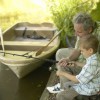 The deployment of a military parent is undoubtedly a difficult time for children. This is especially true if the military child is being cared for by a relative, or kinship parent such as a grandparent, aunt, uncle, or older sibling. The child may have to experience a kind of personal deployment from their own home. To help children cope with these changes, it is important for the kinship parent to effectively communicate with the child about the deployment and the deployed parent. This will safeguard against emotional and behavioral problems and can lead to improvements in the child’s overall sense of well-being. This 3-page fact sheet was written by Elizabeth Thomas and Larry F. Forthun, and published by the UF Department of Family Youth and Community Sciences, March 2013.
The deployment of a military parent is undoubtedly a difficult time for children. This is especially true if the military child is being cared for by a relative, or kinship parent such as a grandparent, aunt, uncle, or older sibling. The child may have to experience a kind of personal deployment from their own home. To help children cope with these changes, it is important for the kinship parent to effectively communicate with the child about the deployment and the deployed parent. This will safeguard against emotional and behavioral problems and can lead to improvements in the child’s overall sense of well-being. This 3-page fact sheet was written by Elizabeth Thomas and Larry F. Forthun, and published by the UF Department of Family Youth and Community Sciences, March 2013.
http://edis.ifas.ufl.edu/fy1367
The EPA Conventional Reduced Risk Pesticide Program (PI224)
 The Food Quality Protection Act (FQPA) of 1996 initiated the U.S. Environmental Protection Agency’s (EPA) Conventional Reduced Risk Pesticide Program. Its purpose is to expedite the review and registration process of conventional pesticides that pose less risk to human health and the environment than existing conventional alternatives. Riskier conventional alternatives are those pesticides EPA deems as having neurotoxic, carcinogenic, reproductive, and developmental toxicity, or groundwater contamination effects. It serves as a means to ensure that reduced risk pesticides enter the channels of trade and are available to growers as soon as possible. This 11-page fact sheet was written by F.M. Fishel, and published by the UF Department of Agronomy, April 2013.
The Food Quality Protection Act (FQPA) of 1996 initiated the U.S. Environmental Protection Agency’s (EPA) Conventional Reduced Risk Pesticide Program. Its purpose is to expedite the review and registration process of conventional pesticides that pose less risk to human health and the environment than existing conventional alternatives. Riskier conventional alternatives are those pesticides EPA deems as having neurotoxic, carcinogenic, reproductive, and developmental toxicity, or groundwater contamination effects. It serves as a means to ensure that reduced risk pesticides enter the channels of trade and are available to growers as soon as possible. This 11-page fact sheet was written by F.M. Fishel, and published by the UF Department of Agronomy, April 2013.
http://edis.ifas.ufl.edu/pi224
Florida Crop/Pest Management Profile: Cabbage (CIR1256/PI042)
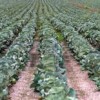 Florida’s cabbage production is exclusively for the fresh market. The higher-quality cabbage obtained during the late fall, winter, and early spring months in Florida allows the shipment of fresh cabbage to areas of the United States that cannot produce cabbage during that part of the year. This 18-page fact sheet summarizes production practices and pest management for cabbage production in Florida. Written by Wael M. Elwakil and Mark Mossler, and published by the UF Department of Agronomy, April 2013.
Florida’s cabbage production is exclusively for the fresh market. The higher-quality cabbage obtained during the late fall, winter, and early spring months in Florida allows the shipment of fresh cabbage to areas of the United States that cannot produce cabbage during that part of the year. This 18-page fact sheet summarizes production practices and pest management for cabbage production in Florida. Written by Wael M. Elwakil and Mark Mossler, and published by the UF Department of Agronomy, April 2013.
http://edis.ifas.ufl.edu/pi042
Produccion de Hortalizas en Ambientes Protegidos: Medios de Siembra y Contenedores (HS1216)
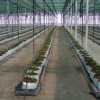 Este documento contiene informacion sobre producción en suelos: Desinfección, mejoramiento, cultivos de cobertura, acolchados (mulches); y tipos de contenedores. This 6-page fact sheet was written by Bielinski M. Santos and Henner A. Obregon-Olivas, and published by the UF Department of Horticultural Sciences, March 2013.
Este documento contiene informacion sobre producción en suelos: Desinfección, mejoramiento, cultivos de cobertura, acolchados (mulches); y tipos de contenedores. This 6-page fact sheet was written by Bielinski M. Santos and Henner A. Obregon-Olivas, and published by the UF Department of Horticultural Sciences, March 2013.
http://edis.ifas.ufl.edu/hs1216
Understanding the Effects of Forage Composition and Structure in Ruminant Nutrition (AN288)
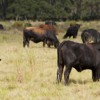 Approximately 68% of the 16 million square miles of agricultural land worldwide is used for permanent pastures for livestock production. Fortunately, ruminants can convert plant matter that is inedible or of low nutritional value for monogastrics (i.e., swine or poultry) into calorically dense products of high nutritional value. However, the process of converting poor quality plant matter into useful nutrients for ruminants is complex. This 3-page fact sheet provides an overview and understanding of how forage composition and structure affect the nutritive value and nutrient availability to ruminants. Written by Kalyn M. Waters, Nicolas DiLorenzo, and G. Cliff Lamb, and published by the UF Department of Animal Sciences, March 2013.
Approximately 68% of the 16 million square miles of agricultural land worldwide is used for permanent pastures for livestock production. Fortunately, ruminants can convert plant matter that is inedible or of low nutritional value for monogastrics (i.e., swine or poultry) into calorically dense products of high nutritional value. However, the process of converting poor quality plant matter into useful nutrients for ruminants is complex. This 3-page fact sheet provides an overview and understanding of how forage composition and structure affect the nutritive value and nutrient availability to ruminants. Written by Kalyn M. Waters, Nicolas DiLorenzo, and G. Cliff Lamb, and published by the UF Department of Animal Sciences, March 2013.
http://edis.ifas.ufl.edu/an288
My Child Has a Mental Illness: Developing Parental Advocacy Skills (FCS2327/FY1365)
 If your child is diagnosed with a mental illness, you will face major changes in your life. Being proactive about your child’s care and advocating for him or her will help you and your child handle the illness successfully. This 5-page fact sheet was written by Tracy DeCubellis, Victor W. Harris, and Martie Gillen, and published by the UF Department of Family Youth and Community Sciences, April 2013.
If your child is diagnosed with a mental illness, you will face major changes in your life. Being proactive about your child’s care and advocating for him or her will help you and your child handle the illness successfully. This 5-page fact sheet was written by Tracy DeCubellis, Victor W. Harris, and Martie Gillen, and published by the UF Department of Family Youth and Community Sciences, April 2013.
http://edis.ifas.ufl.edu/fy1365
Family Reunification Following Foster Care (FCS2328/FY1366)
 Families reuniting after an intervention that requires foster care for the children face unique challenges. Parents in these situations may need to learn about their parental roles, the basic needs for the healthy development of their children, and resources that will help the family in their reunification. Researchers and practitioners in child welfare have provided helpful information to develop workable plans to aid families in reunifying and rebuilding. This 5-page fact sheet is a brief summary of the overarching themes provided by the literature. Written by Rosalyn Monroe and Victor W. Harris, and published by the UF Department of Family Youth and Community Sciences, April 2013.
Families reuniting after an intervention that requires foster care for the children face unique challenges. Parents in these situations may need to learn about their parental roles, the basic needs for the healthy development of their children, and resources that will help the family in their reunification. Researchers and practitioners in child welfare have provided helpful information to develop workable plans to aid families in reunifying and rebuilding. This 5-page fact sheet is a brief summary of the overarching themes provided by the literature. Written by Rosalyn Monroe and Victor W. Harris, and published by the UF Department of Family Youth and Community Sciences, April 2013.
http://edis.ifas.ufl.edu/fy1366
Storage Limitation Statements: Temperature – Herbicides (PI123/PI160)
 This 8-page guide provides information about how temperature affects storage of agricultural herbicides. A table is included that lists many common agricultural herbicides registered for use in Florida, with storage limitation statements. Written by Frederick M. Fishel, and published by the UF Department of Agronomy, April 2013.
This 8-page guide provides information about how temperature affects storage of agricultural herbicides. A table is included that lists many common agricultural herbicides registered for use in Florida, with storage limitation statements. Written by Frederick M. Fishel, and published by the UF Department of Agronomy, April 2013.
http://edis.ifas.ufl.edu/pi160
Urban Turf Fertilizer Rule for Home Lawn Fertilization (ENH1089/EP353)
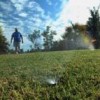 While a healthy lawn typically takes up and uses applied fertilizer for growth and protein production, nutrients may leach or run off into water bodies or groundwater when fertilizer is overapplied or applied to an unhealthy lawn. In an attempt to reduce this nonpoint source pollution, FDACS developed a rule to regulate the amount of N and P applied to lawns as fertilizer. The Urban Turf Fertilizer Rule regulates what can be sold and marketed as an urban turf fertilizer and requires specific wording on the fertilizer bag. This rule was enacted in response to concerns over potential pollution of water resources resulting from the nitrogen (N) and phosphorus (P) in these fertilizers. This 3-page fact sheet was written by Laurie E. Trenholm, and published by the UF Department of Environmental Horticulture, March 2013.
While a healthy lawn typically takes up and uses applied fertilizer for growth and protein production, nutrients may leach or run off into water bodies or groundwater when fertilizer is overapplied or applied to an unhealthy lawn. In an attempt to reduce this nonpoint source pollution, FDACS developed a rule to regulate the amount of N and P applied to lawns as fertilizer. The Urban Turf Fertilizer Rule regulates what can be sold and marketed as an urban turf fertilizer and requires specific wording on the fertilizer bag. This rule was enacted in response to concerns over potential pollution of water resources resulting from the nitrogen (N) and phosphorus (P) in these fertilizers. This 3-page fact sheet was written by Laurie E. Trenholm, and published by the UF Department of Environmental Horticulture, March 2013.
http://edis.ifas.ufl.edu/ep353
Whiteflies on Landscape Ornamentals (ENY317/MG254)
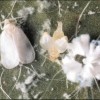 Whiteflies are common pests on many ornamental plants. Some of the most economically important species in Florida are the silverleaf whitefly, fig or ficus whitefly, citrus whitefly, and the rugose spiraling whitefly. The most frequently attacked plants include allamanda, avocado, chinaberry, citrus, fig, fringe tree, gardenia, gumbo limbo, ligustrum, mango, various palms, persimmon, viburnum, and many annuals. This 4-page fact sheet was written by E. A. Buss, and published by the UF Department of Entomology and Nematology, March 2013.
Whiteflies are common pests on many ornamental plants. Some of the most economically important species in Florida are the silverleaf whitefly, fig or ficus whitefly, citrus whitefly, and the rugose spiraling whitefly. The most frequently attacked plants include allamanda, avocado, chinaberry, citrus, fig, fringe tree, gardenia, gumbo limbo, ligustrum, mango, various palms, persimmon, viburnum, and many annuals. This 4-page fact sheet was written by E. A. Buss, and published by the UF Department of Entomology and Nematology, March 2013.
http://edis.ifas.ufl.edu/mg254
Managing Diamide Resistance in Florida Tomato (ENY867/IN978)
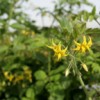 As with any insecticide, repeated use of diamide insecticides on successive generations of the same pest may lead to the development of insecticide resistance. In order to avoid the development of resistance to diamides by targeted pests of tomato, group 28 insecticides, including diamides, must be rotated with insecticides possessing different modes of action. This 3-page fact sheet was written by Hugh A. Smith, and published by the UF Department of Entomology and Nematology, February 2013.
As with any insecticide, repeated use of diamide insecticides on successive generations of the same pest may lead to the development of insecticide resistance. In order to avoid the development of resistance to diamides by targeted pests of tomato, group 28 insecticides, including diamides, must be rotated with insecticides possessing different modes of action. This 3-page fact sheet was written by Hugh A. Smith, and published by the UF Department of Entomology and Nematology, February 2013.
http://edis.ifas.ufl.edu/in978
Citrus Canker Symptoms on Nursery Trees (PP304)
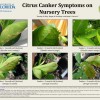 This document is a two-page illustrated identification sheet for citrus canker symptoms that appear in citrus nurseries. Written by Timothy D. Riley, Megan M. Dewdney, and Jamie D. Burrow, and published by the UF Department of Plant Pathology, April 2013.
This document is a two-page illustrated identification sheet for citrus canker symptoms that appear in citrus nurseries. Written by Timothy D. Riley, Megan M. Dewdney, and Jamie D. Burrow, and published by the UF Department of Plant Pathology, April 2013.
http://edis.ifas.ufl.edu/pp304
Guia de merendar saludablemente para el adulto mayor fragil (FSHN1219S/FS222)
 El tomar decisiones inteligentes para la selección de las meriendas ayuda a asegurar que los adultos mayores frágiles satisfagan sus necesidades nutricionales. Estas son algunas meriendas sencillas y nutritivas que son apropiadas para los adultos mayores frágiles. This 3-page fact sheet was written by Paula G. Harris-Swiatko y Wendy J. Dahl, and published by the UF Department of Food Science and Human Nutrition, April 2013.
El tomar decisiones inteligentes para la selección de las meriendas ayuda a asegurar que los adultos mayores frágiles satisfagan sus necesidades nutricionales. Estas son algunas meriendas sencillas y nutritivas que son apropiadas para los adultos mayores frágiles. This 3-page fact sheet was written by Paula G. Harris-Swiatko y Wendy J. Dahl, and published by the UF Department of Food Science and Human Nutrition, April 2013.
http://edis.ifas.ufl.edu/fs222
Preventing Foodborne Illness: Salmonellosis (FSHN0214/FS096)
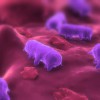 In 2007, there were over 1 million cases and some 400 deaths associated with Salmonella-contaminated food. In 2004, it was estimated that the total economic burden caused by Salmonella infection in the United States was $1.6–$5.3 billion. Food handlers, processors, and retailers can minimize the risk of salmonellosis by using good food handling practices. This 6-page fact sheet was written by Keith R. Schneider, Renée Goodrich Schneider, Michael A. Hubbard, and Susanna Richardson, and published by the UF Department of Food Science and Human Nutrition, March 2013.
In 2007, there were over 1 million cases and some 400 deaths associated with Salmonella-contaminated food. In 2004, it was estimated that the total economic burden caused by Salmonella infection in the United States was $1.6–$5.3 billion. Food handlers, processors, and retailers can minimize the risk of salmonellosis by using good food handling practices. This 6-page fact sheet was written by Keith R. Schneider, Renée Goodrich Schneider, Michael A. Hubbard, and Susanna Richardson, and published by the UF Department of Food Science and Human Nutrition, March 2013.
http://edis.ifas.ufl.edu/fs096